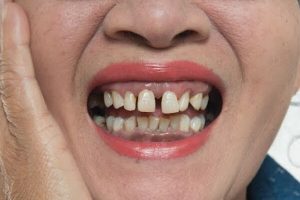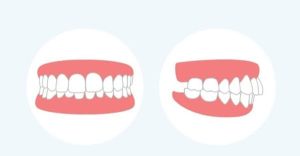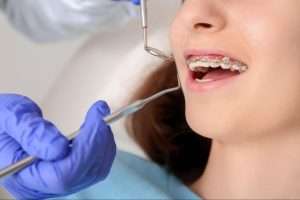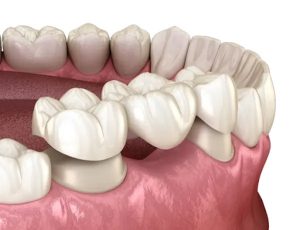Table of content
Many parents come to Elite Dental with the desire to fix their children’s misaligned teeth, helping their children regain confidence with a straight, beautiful smile as well as eliminate the risk of potential oral health. With over 10 years of experience successfully treating hundreds of cases of misaligned teeth in children, Elite Dental aims to share the most basic information about this case and the orthodontic methods, so that parents can ensure timely treatment for their children..
1. Signs Indicating Misaligned Teeth in Children
Misaligned teeth often occur during the stage when children are losing their baby teeth and growing permanent ones. Specifically, parents need to pay attention to the following signs that their child’s teeth are growing misaligned:
- Teeth grow crookedly, crowded, or misaligned in the upper or lower jaw.
- Overbite, the child keeps their mouth open and sleeps with their mouth open.
- Underbite, when the child smiles only the lower jaw is visible.
- Open bite, upper and lower jaws are far apart.
- Deep bite, when the child smiles only the upper jaw is visible.
- Crossbite, is one or more teeth growing in the wrong bite position.
- Gap teeth, large spaces between teeth.

2. Causes of Misaligned Teeth
Misaligned teeth are mainly caused by congenital and genetic factors, including the following:
- Disproportion between teeth and jaw: Large teeth, small jaw, or vice versa.
- Genetics: Facial features such as overbites or underbites can be inherited from parents, overdeveloped or underdeveloped jawbones.
- Early loss of baby teeth: One of the functions of baby teeth is to guide the permanent teeth to grow properly in the jaw. Losing primary teeth early will cause permanent teeth to grow misaligned, crowded, rotated, or overlapping.
In addition to genetic and congenital factors, bad habits can also lead to crooked teeth, such as:
- Thumb sucking.
- Teeth grinding, which wears down enamel and damages biting edges, leading to deep bites.
- Mouth breathing.
- Tongue thrusting, lip sucking, and bottle feeding… will change the balance of the oral environment causing bite misalignment.
3. Impact of misaligned teeth
In the long term, misaligned teeth cause negative effects on children’s quality of life, specifically:
3.1. Aesthetic impact on facial appearance
Misaligned teeth and uneven growth reduce the symmetry of the teeth, resulting in a loss of aesthetic appeal, causing the child to feel self-conscious when smiling or speaking. Moreover, with misaligned teeth due to malocclusion, the child may be unable to close their mouth normally, leading to a lack of confidence with their peers.
3.2. Decreased chewing function
Malocclusion is caused by misaligned teeth, making chewing inconvenient. In addition, this tooth condition is also the cause of temporomandibular joint pain, frequent teeth grinding, etc. Over time, the ability to chew is reduced, potentially harming the child’s overall health and development.
3.3. Increased risk of oral Health Issues
Misaligned teeth make oral hygiene more difficult, leading to food particles and plaque being trapped in the gaps between teeth. This increases the risk of oral diseases such as tooth decay, gingivitis, etc.
3.4. Mispronunciation
Pronunciation is directly affected by the coordination between teeth, lips, and tongue. Therefore, when teeth grow crowded together, especially when the front teet grow misaligned, it can cause speech difficulties such as lisping or slurring, and a lack of confidence in communication.
4. When is the best time to detect dental malocclusion in children?
The tooth replacement period of 6-12 years old is the “golden” time for parents to monitor and detect early abnormalities that cause misaligned and crowded teeth. Timely intervention can help children change teeth smoothly and safely, and have a beautiful and healthy smile when they grow up.
The period from 6 to 12 years old is when the first permanent teeth appear, the baby teeth are gradually replaced and the jawbone is also growing. During this period, bad habits from childhood such as prolonged bottle feeding, thumb sucking, etc. will change the shape of the jawbone and affect tooth growth.
In addition, the number of permanent teeth is 12 more than baby teeth and is also larger in size. Therefore, when permanent teeth form, it can cause crowding and misalignment. Not to mention, poor dental care and hygiene can cause children to lose baby teeth early and increase the possibility of uneven permanent teeth growing.
These are the reasons that explain the situation where many children have evenly grown baby teeth but develop misaligned teeth after the replacement.
View more: Essential information about braces for your kids
5. Orthodontic solutions for correcting misaligned teeth
Currently, there are 2 commonly used orthodontic methods to correct uneven and misaligned teeth in children.
5.1. Using orthodontic appliances (6 – 12 years old)
This method is applied to children from 6 to 12 years old who have misaligned teeth and jaw bone abnormalities such as underbite, overbite, etc. Specifically, the dentistr conducts treatment in combination with orthodontic appliances to intervene and correct the misalignment of the teeth from an early stage.
The four orthodontic appliances used include:
- EF functional orthodontic appliances are used to correct dental and jaw misalignments such as crowded teeth, crooked teeth, open bites, deep bites, and protruding upper jaw. When treated with this appliance, children need to wear it for at least 2 hours during the day and maintain wearing it throughout the night.
- The HEADGEAR Appliance for Overbite Correction: This appliance helps control or stimulate the growth of the upper and lower jaw bones to ensure harmonious jaw development and proper bite alignment, reducing the severity of the child’s overbite. The time children wear the HEADGEAR appliance for a minimum of 10–12 hours daily.
- Facemask Appliance for Underbite Correction: This appliance is used to correct underbites by applying a pulling force on the upper jaw, anchored on the forehead and chin, to bring the upper jaw forward while controlling the growth of the lower jaw. Children need to wear the Facemask appliance for at least 8–12 hours each day in the evening and at night.
- Quad-Helix jaw expansion device is used for children aged 9 years and older, this appliance helps improve cases of uneven jaw development, narrow jaws, crowded or misaligned teeth, and overbites or underbites. At the same time, this device also helps create suitable space for permanent teeth during the process of tooth replacement, helping to adjust the jaw to develop proportionally.
>> Discover more detailed information about orthodontic appliances for kids HERE.
5.2. Braces for crooked teeth
With the choice of braces for children with crooked teeth, there are currently 2 widely used methods: fixed braces and Invisalign clear braces.
5.2.1. Fixed braces for children
This method of treating misaligned teeth involves attaching fixed braces made of metal or ceramic to the child’s teeth, typically between the ages of 10 and 12, after the completion of orthodontic treatment with appliances (the exact time depends on the doctor’s treatment at the clinic). Depending on the degree of misalignment of the child’s teeth, the braces process can last from 1-2 years.
The advantage of fixed braces is that they are highly effective in many cases of misaligned teeth and misaligned bites at an average price. However, this method is less aesthetic than clear aligners due to the exposed brackets and elastic bands, and they can feel uncomfortable and restrictive for children.
View details: > Metal Braces > Ceramic Braces > Comparison of Ceramic Braces and Metal Braces
5.2.2. Invisalign Clear Aligners for Children
This is considered one of the most advanced digital orthodontic techniques, offering the most efficient teeth movement in modern dentistry. The braces are specifically designed according to the child’s jaw and tooth size to hug the teeth and apply force to help move the teeth according to the doctor’s treatment plan.
The advantage of Invisalign braces for crooked teeth is that they are highly aesthetic, helping children feel more confident when communicating. It also makes eating easier, as there are no wires or brackets to irritate the lips. Additionally, children can remove the aligners during meals, making it simple to clean them and maintain good oral hygiene.
View more: Exploring 5 Types of Invisalign Treatments – Find the Right One for You
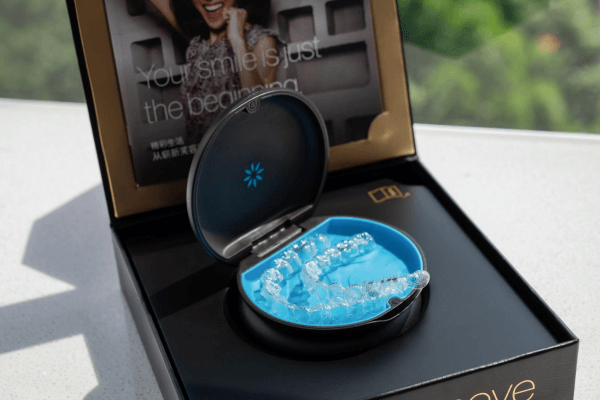
Invisalign clear aligners are used in the following cases:
- At the stage when the child changes the last tooth when he or she reaches the age of 10 – 11 years old.
- After the child has completed the process of correcting bone misalignment (if any).
- In case the child has mild jaw narrowing or deviations such as crooked, crowded, spaced, protruding or underbite teeth due to teeth.
6. Where is the Best Place to Correct Misaligned Teeth in Children?
Treating crooked teeth in children is a top concern for many parents. Therefore, parents should choose a reputable dental clinic with expertise and experience in treating dental misalignments to ensure optimal results and restore a confident, beautiful smile.

Elite Dental is a reputable orthodontic address in Ho Chi Minh City with over 10 years of experience. In particular, Elite Dental is a dental center with a team of experienced and highly skilled orthodontists who directly plan the exact treatment and have a timely intervention to help children have standard teeth and bite, and maintain a beautiful smile.
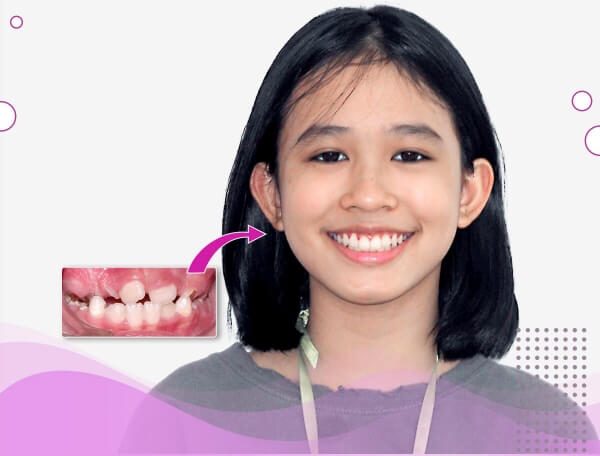

In addition to advanced technology and equipment, Elite Dental has a team of orthodontists with experience from international programs and hundreds of successful pediatric orthodontic cases. With an understanding of children’s psychology and a caring, attentive approach, parents can feel assured when bringing their children to Elite Dental. The clinic also features a specially designed treatment area and play zone to ensure a comfortable and enjoyable orthodontic experience for children.
To closely monitor your child’s teeth and promptly correct misaligned teeth, parents should make an appointment with Elite Dental HERE.
Related posts: > Receding Chin: What It Is, Symptoms, Causes, and Solutions > Elite Dental: Children’s Orthodontic Treatment Price List > Bracing Your Child’s Teeth: Tips and What to Know



